|
Monday, Janury 5, 2009
Progress Notes
Last week I wrote about a couple of Miller County citizens of the past (Jack Clark and Joe Safire) who had immigrated to our county in the twentieth century. This week I will review some history of the 19th century when the majority of our ancestors arrived here from the East. Most Miller County early settlers were of Scotch/Irish, English, or German origin. Those who originated from the British Isles came a few years before the German population. However, both groups made up the majority of the settlers who decided to stay here on their journey to the West.
Peggy Hake (photo 01) has written an extensive history of a group of German settlers, almost all Protestants, who came to Miller County mostly by land and who settled in the Iberia area.

01 Peggy Hake
Since most came from Pennsylvania sometimes they are called the “Pennsylvania Dutch.”
Dale Doerhoff (photo 01a), originally of St. Elizabeth, has written about the German Catholic population which arrived here by water transportation coming up the Missouri and then the Osage rivers.
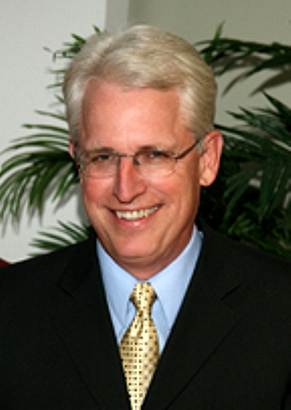
01a Dale Doerhoff
This group of immigrants settled at several locations along the Osage with the most upstream settlement being that of St. Elizabeth. I will copy here a short summary written by Dale of the Miller County Catholic German population; however, I want to recommend the extremely well written and researched book about this subject Dale published in 2006: A Trip to Charleytown: The German-American Community at St. Elizabeth, Missouri 1880-1920 (2006), 425 pages.
David Bear (photo 02), originally from Tuscumbia, has recorded the history of his Protestant German family which arrived here by water coming up the Osage River as did the German Catholics.
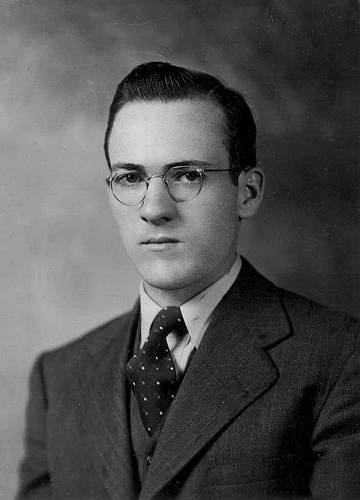
02 David Eli Bear
His family settled near the Osage River about ten miles upstream from St. Elizabeth.
This week I will present narratives by all three authors giving the history of the German immigration to our county. First is the narrative by Peggy Hake:
Many Miller Countians Have Dutch Heritage
Peggy Smith Hake
The Miller County Autogram Sentinel, Thursday, January 7, 1988
There are so many families living in Miller County today (primarily in the Big Richwoods area) who are descended from the most remarkable pioneer folk you will ever hear about. These were the Pennsylvania Dutch ancestors who left their eastern homes to travel westward in search of a new land to homestead and settle.
In the time era of 1859, prior to the outbreak of the Civil War, Colonel James Moore and Matthew Brown joined forces and brought their families to Missouri. Both families traveled by train from Pittsburg, Pennsylvania to St. Louis; crossed the mighty Mississippi on a ferry boat; and traveled the remainder of the way by wagon. They brought a great deal of furniture and other items with them on this long trip including a Lincoln bedstead, a bureau, a flax spinning wheel, a stove with an oven on top, an old fashioned child’s cradle, silverware, chinaware, and several old books which today would be classic rarities. These books printed on homemade paper and bound in leather, pertained to history, philosophy, religion and classics of Greek and Latin. The publication dates ranged from 1813 to 1856; the oldest one in their possession was “The Book of Martyrs” by John Malkam (1813). I understand that Mrs. Charles Newhart, a granddaughter of Colonel James Moore, had possession of all these articles in the 1930’s.
Colonel James Moore had been a Curator of the Lewisburg, Pennsylvania (now Bucknell) University. His son, Edward, graduated from this fine, old school in 1852.
Matthew Brown was born in Lycoming County, Pennsylvania near Williamsport in 1795. When he attained manhood, he moved to Clearfield, Pennsylvania and purchased a newspaper called The Clearfield Banner which he continued to publish until 1837. That year he went back to his home county and settled near Uniontown (now Allenwood) and engaged in general merchandising and he conducted a profitable business until his decision to move west. While at Uniontown, he owned the farm where he was born, two miles west of the small village. There he erected the largest barn in White Deer Valley in east central Pennsylvania. In the spring of 1859, the Brown’s and Moore’s left White Deer Valley, Lycoming County, Pennsylvania and headed toward Missouri.
I am in awe of these pioneers when I realize they were prosperous businessmen and landowners in their eastern homeland, but decided to start out on a new adventure in a strange land. It was told by the old timers that they hoped to find a good country to raise cattle and also provide work for their boys who may otherwise have grown up in idleness.
When the Pennsylvanians arrived in Miller County, they found the country wild and sparsely populated. Grass, higher than one’s head, covered much of the fields and hills. Wild animals and game were plentiful, such as the deer, wolf, quail, turkey, fox, rabbit, and squirrel. The hills were covered with dense woods in part of the Big Richwoods with the oak and walnut most prevalent.
The Brown family purchased a tract of land containing 415 acres near the Tavern creek south of Iberia. Matthew called his new farm “Brownsylvania.” In later years the farm was owned by David Petrikin, a grandson of Matthew Brown and today is owned by the John Porter family. Colonel Moore bought a place adjoining the Browns toward the west containing 400 acres. Both families built log homes on their newly acquired Missouri land. These homes were a “new breed” of architecture introduced to our part of the country.
The log houses were first built as two separate one room units but connected with a common roof. They were known as “dog trot” houses and inside the covered space, between the two log cabins, hung the winter’s supply of dried vegetables, wild animals’ skins, sides of bacon and seed corn for next year’s planting. Each unit had its own fireplace and as their family increased, rooms were added to the top of each cabin with an outside stairway for access. The only heat these rooms had was what drifted up from the room below.
Colonel Moore put up a building and opened a general store in the area south of Iberia. He had forwarded a stock of goods from Pennsylvania so that he could establish his mercantile trade in Miller County. But his store was short lived because after only a few months, Colonel Moore died and his family had to close their new business.
Within a short time after their arrival in Miller County, the Civil War broke out. The Pennsylvanians were northern sympathizers. They entered this war, serving the Union forces, and John D. Brown, son of Matthew, was wounded at the famous Battle of Wilson’s Creek near Springfield. He also participated in battles at Prairie Grove, Arkansas and Vicksburg, Mississippi.
The Pennsylvanians had rough times during those dark years of Civil War. They were northerners and had supported Abraham Lincoln in the election of 1960. Many men of the county were Confederate sympathizers and they formed a military company in the early spring of 1861, pledging allegiance to the Southern cause and favored secession.
In May of 1861, Articles of the Confederation were drawn up by officers and riders of this newly formed company and they issued messages to all the Dutchmen in Richwoods township including the Pennsylvania Dutch and the German immigrants, that they must sign this Oath of Allegiance…but nobody responded! Talk about grit! There followed in the ensuing months, attempted lynchings; beatings; destruction of homes, livestock and harvested crops; abandonment of farms for long periods of time. This harassment continued on for many months.
When military groups were formed in the Union army, the younger Pennsyvanians enlisted and fought in many battles. Some of the soldiers were: John Brown Tallman; Jeremiah W. Tallman, son of William Tallman; Jeremiah Tallman, son of Charles Tallman; William Brown Tallman and John D. Brown.
After the war Jeremiah Tallman (photo 03) became active in Miller County politics serving as Sheriff, Judge of the Probate Court; and three times elected County Treasurer.
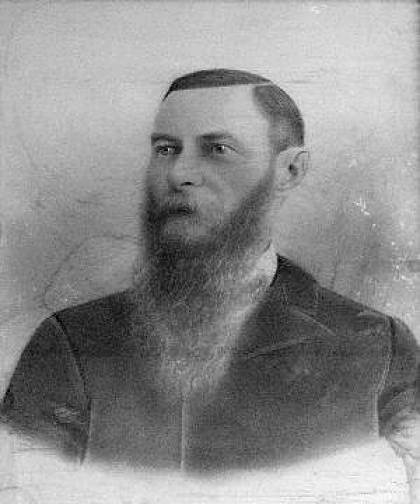
03 Jeremiah Tallman
Charles Tallman served as a justice of the peace for a number of years; served a term as associate judge of the County Court; and was appointed by the governor to an important office in January, 1869, but he died one month later from lung congestion.
The families of Charles and William Tallman, John Bennage, Benjamin Groff, all of Lycoming County, Pennsylvania and William Irwin of Mifflinburg, Union County, Pennsyvania, came to Missouri just shortly before the Civil War. Colonel Moore had written these folks telling them that the land was cheap; the country side desirable, and a man’s living was easy in Missouri. Due to his urging, they all moved here about the same time in the mid 19th century.
William Tallman was educated in the public schools at Williamsburg and his first job was working for his father in the boat and shoe business. He later worked in Philadelphia at the same trade. He learned surveying and assisted in laying out the new town of Lock Haven, Pennsylvania before finally getting the ‘westward fever.’
Charles Tallman spent most of his life on his father’s farm across the west branch of the Susquehanna River near Williamsport. (This is gorgeous country! I took a trip through our eastern seaboard states in 1976 and I followed the Susquehanna River across Pennsylvania through Williamsport, Harrisburg, and southward into Maryland).
Charles Tallman married Isabella Brown and they settled in White Deer Valley near the old Brown homestead. He and Isabella reared their children on this farm and in their later years of life they sold out and came to Miller County, arriving in April of 1860. Charles died in 1869, only one month after being appointed to an important job by his personal friend, Joseph Washington McClurg, Missouri’s Governor from Camden County, elected in November, 1868.
After the war, the families of David Farnham, John Hedge, William Newhardt, John Clark, John Hess, George Johnston, and George Heltzell came to Miller County from Lycoming County, Pennsylvania. All these families remained, except the John Hess family, and their descendants are numerous today. Most came by train arriving in Arlington, approximately 30 miles southeast of Miller County in Phelps County, and traveled the rest of the way by wagon. A few came by steamboat up the Ohio, the Mississippi, and the wide Missouri to Jefferson City, and finished their trek by wagon.
The families homesteaded chiefly in the Iberia vicinity. They began planting fields of corn, wheat and alfalfa. They also raised vegetables and planted a great deal of tobacco on their new acreage.
Most attended the only church in the area which was the Big Richwoods United Baptist Church of Christ, but known over the years as ‘Sulky Church’ (of course, there is another story behind that name, as you might guess). The church was an old log structure, erected on the site of Iberia’s city cemetery. Some old graves can still be found that surrounded the old church, but I am sure there are many pioneers lying in the area in unmarked graves.
The Pennsylvania children attended the one room, log school called Allen School. It was located about one mile east of present day Iberia. The land for the school was donated by a Kentuckian, Elias Allen, and was the only school near Iberia for many decades. The school term only lasted about three months in the fall of the year after the crops were harvested and the only subjects taught were reading, writing, arithmetic and spelling.
Through the years, these Pennsylvanian pioneers continued to be important assets to our community. In 1890, when the Iberia Academy was begun, the children of these pioneers were among the school’s first students. By 1930, the Academy had graduated 299 students and 40 of that number were descendants of Pennsylvania settlers. These graduates continued on in higher schools of learning and became very successful men and women……John Bennage sent five of his children through this Academy. Three children of John D. Brown; grandchildren of Matthew Brown; eight grandchildren of David Farnham; two grandchildren of Benjamin Groff; one granddaughter of John Hedge; one grandson and one great granddaughter of Colonel Moore; two daughters of George Johnston; four grandchildren of William Irwin; three grandchildren of George Heltzell; and two great grandchildren of Charles Tallman were among those who had graduated from the Academy by 1930 and after that date, the newer generations of these Pennsylvanian settlers continued on until the school’s closing in 1951.
The Pennsylvanian Dutch pioneers left their eastern homes almost 130 years ago, settling in Mid Missouri, searching for their promised land. Here they found bounty in the fields as they tilled the rich earth of the Big Richwoods. It was said that they were in “a promised land where you have no need to work for the land is so rich you may plant a crowbar at night and it will sprout ten penny nails by morning.” This was a farfetched, enthusiastic report of our Missouri country, but it brought settlers to our territory and they left us a wonderful heritage.
Thanks Peggy.
Once I asked my grandfather, Madison Bear, whose German ancestors came to Miller County in 1857, why the Germans who came to Miller County were called Pennsylvania Dutch rather than Pennsylvania Deutsch, which is the German word referring to natives of Germany, while Dutch was a word referring to natives of the Netherlands. He told me that it was a corruption of the words Dutch/Deutsch by Americans of English origin who made the error because of the similarity of the way the two words are pronounced. Thinking more about that question this week I looked it up on Wikipedia and this is what that source has to say:
The Pennsylvania Dutch (perhaps more strictly Pennsylvania Deitsch, Pennsylvania Germans or Pennsylvania Deutsch) are the descendants of German immigrants who came to Pennsylvania prior to 1800. According to Don Yoder, a Pennsylvania German expert and retired University of Pennsylvania professor, the word "Dutch" in this case owes its origin to an archaic meaning where it designated groups that are today considered German and Dutch — prior to the Thirty Years' War, the Netherlands were part of the Holy Roman Empire and the Dutch were generally regarded as one of several German peoples. This is also reflected in the fact that the German endonym (Deutsch), the archaic Dutch endonym (diets(ch)) and the modern Dutch word for "German" (duits) are all cognates. Although Yoder rejects other explanations, other sources, such as Hostetler (1993) give the origin of "Dutch" as a corruption or a "folk-rendering" of the Pennsylvania Dutch's endonym "Deitsch".
Pennsylvania Dutch were historically speakers of the Pennsylvania German language. They are a people of various religious affiliations, most of them Lutheran or Reformed, but many Anabaptists as well. They live primarily in southeastern Pennsylvania in the area stretching in an arc from Bethlehem and Allentown through Reading, Lebanon, and Lancaster to York and Chambersburg. They can also be found down throughout the Shenandoah Valley (the modern Interstate 81 corridor) in the adjacent states of Maryland, Virginia, West Virginia and North Carolina, and in the large Amish and Mennonite communities in Mifflin County, Pennsylvania, in Ohio north and south of Youngstown and in Indiana around Elkhart. Their cultural traditions date back to the German immigrations to America in the 17th and 18th centuries. Only then did German immigration from various parts the southern Rhineland, Palatinate, the southern part of Hesse, Baden, Alsace and Switzerland gain momentum, and soon dominate the area. But the Pennsylvania Dutch language is ultimately a derivative of Palatinate German.
And now the narrative by Dale Doerhoff which is copied from our own website at:
http://www.millercountymuseum.org/communities/stelizabeth.html
St. Elizabeth
Early Values and History of City Reviewed
By Dale C. Doerhoff
The story of St. Elizabeth begins in Germany, and it begins with a man named Duden. Dr. Gottfried Duden, who studied both medicine and law, came to Missouri in 1824 from Germany. He was from the Rhine River region of Germany, and he found the Missouri River Valley to be like his native region. He wrote colorful letters home, setting out the advantages of living in Missouri.
In 1829 he published a book about what he had found. The book's title, when translated into English, was: "A Report of a Journey to the Western States of North America." Duden's book was widely circulated in Germany. It went through three editions.
By 1837 there were 30,000 German immigrants in Missouri. The largest influx came after 1848. In that year revolution spread across Europe. By 1860, there were 88,000 German immigrants in Missouri. 50,000 were in St. Louis. Others came up the Missouri River and settled in its tributaries, the Osage, Maries and Gasconade Rivers.
They began moving into eastern Miller County about 1870. Old St. Elizabeth, located on the Osage River upstream from the mouth of the Big Tavern Creek, was established in 1869 (photo 04). Old St. Elizabeth was abandoned in favor of the present site of St. Elizabeth which was established in August of 1880. Mary's Home formed around 1883. The building of St. Anthony began in 1906.
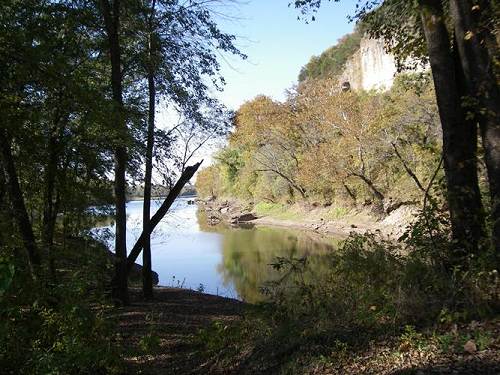
04 Tavern Osage Confluence
What kind of people were the German immigrants? Their language was different, but in substance they were not much different from the present citizens of St. Elizabeth. That is because many of the character traits of today were handed down from those settlers of long ago. First, they were patriotic and willing to fight for their country. Although they were not native-born Americans, 31,000 Missouri Germans served in the Union Army, making Germans 40 per cent of the total.
Another early trait was a commitment to quality education. The German immigrants were an educated lot. They had good schools in Germany, and when they moved here, they continued that tradition. There are other traits those of today owe to their ancestors. One trait is pride in homes and farms. The German settlers built big houses, usually two stories high. Another trait of the German immigrants was their emphasis on religion. They built their churches in the centers of their towns. They built them large and they built them of permanent materials so that they would last (photo 05 of St. Lawrence Church and photo 06 of Old St. Elizabeth Cemetery).
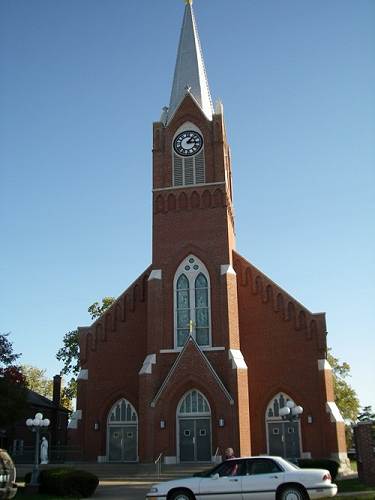
05 St. Lawrence Church
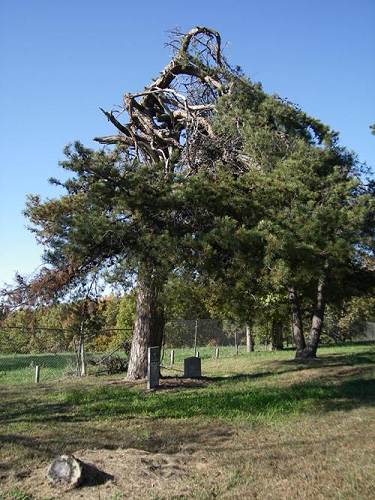
06 Old St. Elizabeth Church Graveyard
The German immigrants brought along some bad traits with the good. One of these was their taste for spirits. The grapevines growing by many of the older houses in St. Elizabeth were not planted to make jelly.
Although the German-Americans at St. Elizabeth had a different language, religion and cultural background than the rest of Miller County there never was an effort by the people to isolate themselves from the other people of the county. Take for example the county bond issue of 1911. The Miller County Court ran out of funds before the courthouse was finished. They submitted a bond issue to the voters to raise $10,000 for this project. In St. Elizabeth there were 41 for the bond issue and 0 opposed, the only precinct in the county without a "no" vote. The bond issue failed to gain the necessary two-thirds majority.
The centerpiece of today's celebration, the Christmas tree, did not appear in America until the German immigrants arrived in numbers. The first Christmas tree in the White House came in 1856. Of course nearly every home in St. Elizabeth had a Christmas tree that year as they had for many years before that. Christmas was always an important religious feast and social event.
One unusual Christmas season custom observed at St. Elizabeth since its founding is the observance of the feast of St. Nicholas on December 5th. On the evening of December 5th St. Nicholas visits the homes of children. St. Nicholas himself is not so bad. He looks like Santa Claus, asks if the children have been good and asks if they can say their prayers. It's his companion, the devil that makes a visit so frightening. For a child is reported to have been bad or cannot say his prayers, he is seized by the devil, wrapped in the devil's chain and dragged screaming into the blackness of night. They say that one very bad child never was found, but nobody remembers who he was.
Thanks Dale.
And now the narrative by David Bear about his family’s journey to Miller County:
George Bear Family
By David Eli Bear
In September, 1857, George Bear (photo 07) sold his livestock, household goods, and farm implements at public auction at his farm in Ohio, and shortly thereafter the family left for the west headed to Kansas.
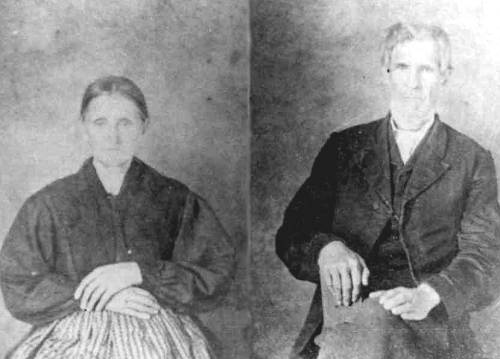
07 George and Elizabeth Bear
They booked passage on a steamboat from Cincinnati, Ohio, and then took another steamboat to St. Louis, Missouri. In St. Louis, George purchased a covered wagon which he hitched to a team of horses that he had brought from Ohio. The family then set out for Kansas with all the family walking except for the females and young David Bear, George's youngest son. They followed a well established trail that stayed south of the Missouri River. The coming of winter and the onset of illnesses of the season dictated a layover somewhere in Missouri until springtime, so they headed south looking for a place to spend the next few months. The family crossed the Osage River at Tuscumbia and continued south finally stopping for the winter in a protected hollow near the present Miller County Nursing Home. The children ranged in ages from five to twenty three years, so several of the young men were able to contribute to the hard work required to subsist.
In the spring of 1858, George made a decision to stay in Missouri to avoid the hostilities that were going on in Kansas that resulted from passage by congress of the Kansas-Nebraska bill. Also, George liked the Ozark hill country which was similar to his southern Ohio home where hunting and fishing had abounded.
A small tract of land was purchased on Coon Creek 3.5 miles east of Tuscumbia. Additional purchases increased the size of the farm to 180 acres. The previous owner had already constructed a two story house made with hewn logs with puncheon floors. The original portion was 18 by 20 feet. This room was connected to the original building by a breezeway and this addition became the kitchen and dining area. Cooking was done over the fireplace. Life was rugged for all, but hard work was all they knew, so there was no problem of acceptance of their lot.
April 12, 1861, ushered in the Civil War which had a major effect on this family. David, George's youngest son, was eight years old at the onset of the war. Six of his brothers served in various units of the Union forces. With many of the young men gone to serve in the military, the home front was left with less protection. Guerrilla war skirmishes occurred, and bushwhacking was a threat. Young David lived these early years with all the uncertainties of war. His schooling was interrupted because the schools were closed for the safety of the pupils. David often spoke with regret that he had too little schooling. He probably received some basic instruction from his sisters who spoke and read English. The German language was the one used by the parents when talking to one another. His own desire to learn enabled him to become a good reader. His performance in adult life indicated that he was literate and well informed about the Bible, current events, history, etc. He was probably better educated than most men of his country. David grew up on the family farm. After the older boys returned from fighting the Civil War, many married, bought their own land and became farmers. John settled south of the Osage River near Tuscumbia. Andrew bought a farm adjoining his parent's farm. George Jr. purchased land with abutted on Andrew's farm, and Simeon purchased land adjacent to George Jr. All three of these farms were in the Dog Creek bottom just a short walk from the farm of their parents on Coon Creek. Henry bought land at Ulman, and Absolom moved to the Hickory Point Community just a few miles from Iberia.
Madison was a wanderer and moved to Arizona territory and bought land in the mouth of Ramsey's Canyon south of Tombstone. He died on December 26, 1882 at the age of thirty-seven years. A letter from G.G. McGee from Contention, Arizona Territory, stated that Madison died of "quick consumption" and was buried the next day at the mouth of Ramsey's Canyon in the Huachuca Mountains. He was sick about fifty days and was rational up to the time of his death. I am not certain whether this lay diagnosis was tuberculosis. If so, this could have been the reason for Madison going to Arizona to begin with.
Benjamin died on January 9, 1879, at age 28. The cause of death is unknown. He never married.
David was the only son of George who stayed on the home place and helped with the farming. His sisters, Mary Ann and Catherine remained at home and never married. David married Mary Samantha Winfrey in 1881 and brought her to the family farm. His father George died in 1876, and his sister Mary Ann died in 1877. By the time David moved his new wife to the family farm, his mother, Elizabeth, and his sister, Catherine, were the only ones still living there. Later, after the death of John's first wife, his two children joined the household. Their names were John Wesley and Minnie. David became the owner of the family farm after the death of his mother, Elizabeth in 1887.
Thanks David.
Of course, these three narratives by no means cover the entire story of the German migration to Miller County throughout the 19th century. Many descendents with various German surnames still live here and can tell their own stories of how their families made their way west as part of the great national migration of immigrants looking for a better life, hopeful they could establish ownership of their own piece of private real estate, something that was beyond their means in the East.
You may remember that Peggy Hake in the above narrative observed that a common feature of the early log cabins was the construction of a breezeway between two different log structures for which reason they were called “dog trot” houses. David Bear in his narrative above described a similar type house on the Bear farm. Many if not all these types of homes, even if still standing, have had the breezeway enclosed so it is not easy to know now which were and were not originally “dog trot” homes. However, one such house which was constructed in this manner remains and is known as the Myers Home (photo 08).
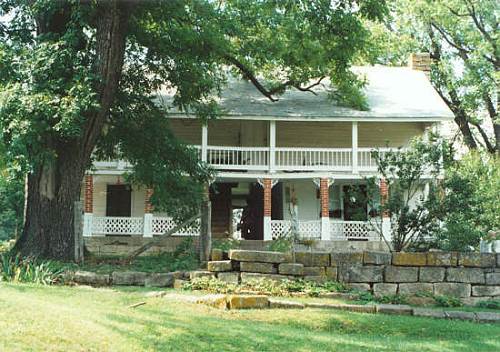
08 Myers Homestead - 1992
You can read more about this home as written by Peggy Hake at this location on our website:
http://www.millercountymuseum.org/homesteads/myers.html
Because this type of home was somewhat common early on in our history we have featured its construction with a facsimile we built in our recently renovated museum. In this photo (photo 09) you can see the two sides of the passageway where the two rooms were constructed.
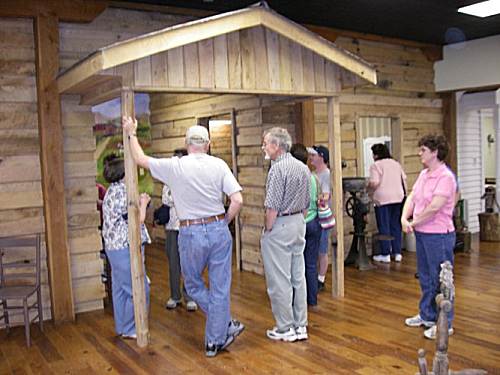
09 Dog Trot House
In this next photo (photo 10) taken from the entrance of the passageway you can see the beautiful mural depicting the landscape behind the house as seen from the entrance of the passageway.
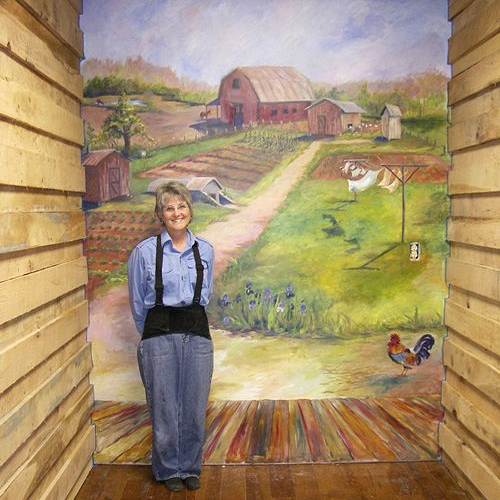
10 Mary Gainey in front of Dog Trot House Mural
The artist who painted the mural is Mary Gainey, former Eldon School Teacher, and she is the one you see in the photo smiling proudly just after she finished her beautiful rendition of an Ozark farm yard.
Having devoted the first part of this narrative to the history of the German migration to Miller County I think I will end with the story of one of the early English arrivals to our area who was important in our history, Isaac M. Goodrich. Isaac M. Goodrich came first to Tuscumbia but later some of his descendents moved to Eldon and established large farming operations there. Once again, I depend on the historical research of Peggy Hake to tell us the story:
ISAAC M. GOODRICH
Isaac M. Goodrich, an early political figure of Miller County, MO., was born in New York on July 29, 1823. He had roots deeply embedded in northeast New England. His father was a native of New York and his mother was born in Vermont. Circa 1845, Isaac married Rebecca S. ____ who was born in Ohio. Their three older children were all born in the Buckeye state. Sometime in the early 1850s, the Goodrich family moved to Miller Co., MO, and settled near Tuscumbia. It did not take very long for Isaac to get involved in local politics. In 1859 he was elected assessor of Miller County. During the 1860s he served as clerk of the circuit court, clerk of the county court, probate judge, and superintendent of public schools. During the civil War, Isaac held the office of clerk of both the circuit and county courts. While the war raged on both sides of the Osage River, county government at Tuscumbia came to a screeching halt! With the assistance of Capt. Sayles Brown and his cavalry of 50 soldiers, Isaac carried Miller County's important county records to the state capitol at Jefferson City, MO., for safekeeping. For almost a year there was no county government in control. It was in the spring of 1865 that court finally convened once again at Tuscumbia.
After tenure as a county official, Isaac became a newspaperman, owning about three different newspapers during the decade of the 1870s. They were among the county's earliest newspapers called "The Sun and Republican", "The Miller County Vidette", and "The Miller County Republican".
Isaac and Rebecca Goodrich had 8 children including:
1. Margaret S. b c/1844 Ohio
2. Isaac Rodoluphus b c/1846 Ohio
3. Matilda S. 1848 - 1863
4. Sarah E. b 1853 MO. m Wm. H. Hauenstein 1872
5. Arthur F. 1857 - 1874
6. Frederick A. 1859 MO
7. Edith R. b 1863 MO m Seigel Beckner of Laclede Co., MO
8. Walter S. b 1868 MO. m Frances L. ?
In 1900, Isaac and Rebecca had been married 55 years and were living in or near Tuscumbia. The late Homer C. Wright of Tuscumbia told me at one time that Judge Goodrich's house sat on the land where the Tuscumbia Clinic (today the law offices of Kerry Rowden) is sitting. It was a stately, two-story home overlooking the Osage River that flowed in a northeasterly direction through Tuscumbia. The Goodrichs' were a prominent family of Equality Township in the late 19th century. When Isaac bought a fine, new buggy in June 1881, it was newsworthy! The news item in the local newspaper stated he had paid $130 for his buggy and it was shipped to Tuscumbia via the riverboat, "Phil E. Chapell".
Isaac died in 1911 at the age of 88 years. His wife, Rebecca, lived for two years longer, dying at the age of 91 years in 1913. They are both at rest in the Tuscumbia town cemetery.
They also have 2 children buried at Tuscumbia.
Isaac M. Goodrich 29 July 1823 - 9 July 1911
Rebecca S. Goodrich 7 Dec 1822 - 13 May 1913
Matilda S. Goodrich 1848 - 1863
Arthur F. Goodrich 1857 - 1874
Thanks Peggy.
Peggy mentioned that Isaac Goodrich built and lived in a large house on the hill overlooking the Osage River valley next to where the Tuscumbia School buildings now are located (photo 11).
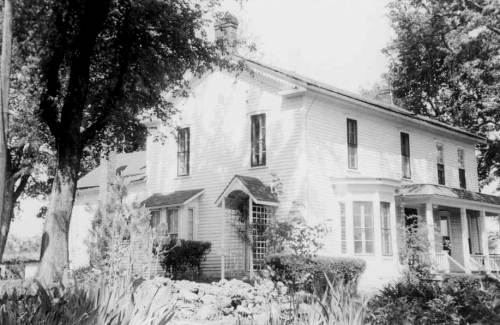
11 Goodrich Home
After he died one of his daughters, Edith (Goodrich) Beckner lived there until the early part of the last century after which the property was purchased by the Pickens family. In my memory the house was known as the Pickens residence, even after both Mr. and Mrs. Pickens had passed away. Dr. Marshall Humphreys (photo 12) bought the property and moved his medical office from the Tuscumbia Bank building to the Pickens house.
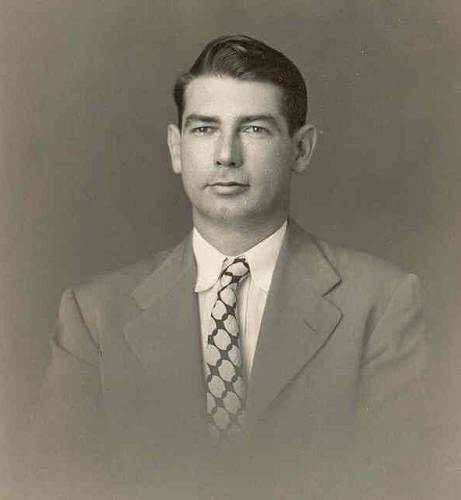
12 Dr. Marshall Humphreys
Later, he built a stone home next to the Pickens house. In 1953 Dr. Humphreys built a new hospital and joined it to the Pickens house. For many years the Humphreys’ Hospital was a center of medical care in central Missouri. Many people in this area and from good distances away can claim the Humphreys’ Hospital as their birthplace. You can read more about Dr. Marshall Humphreys on a previous Progress Notes from 2007.
The Goodrich Home on the hill was part of a large tract of land owned by the Goodrichs’ including all the land north along Highway 52 extending almost to what is now named Catfish Road. To the south the property included all the bottom land on both sides of Highway 17 up to the Osage River Bridge. The entire valley running north from the junction of Highways 52 and 17 was part of the estate. Here is a copy of an old Tuscumbia map which shows the large Goodrich tract on the right (East) side of Tuscumbia (photo 13).

13 Old Map of Tuscumbia
Goodrich also owned a smaller tract which is located in the left upper corner of the map. Dewey Kallenbach told me once that the first annual Tuscumbia Picnics were held at the big spring located at the north end of the big valley running north. He also said that the first Tuscumbia baseball field was located on Goodrich Farm property on the part of the land which bordered Highway 52 going north out of town toward Eldon.
All of the land along Highway 52 going North out of Tuscumbia toward Eldon has been sold through the years. The Goodrich Home site itself is now owned by Kerry Rowden; however, the original home no longer is standing although the Humphreys’ Hospital addition building remains. The remainder of the farm now is owned by a partnership which includes Dr. Jay Shelton, a grandson of Tuscumbia born native, Arthur Bear, who passed away a couple of years ago.
That's all for this week.
|



